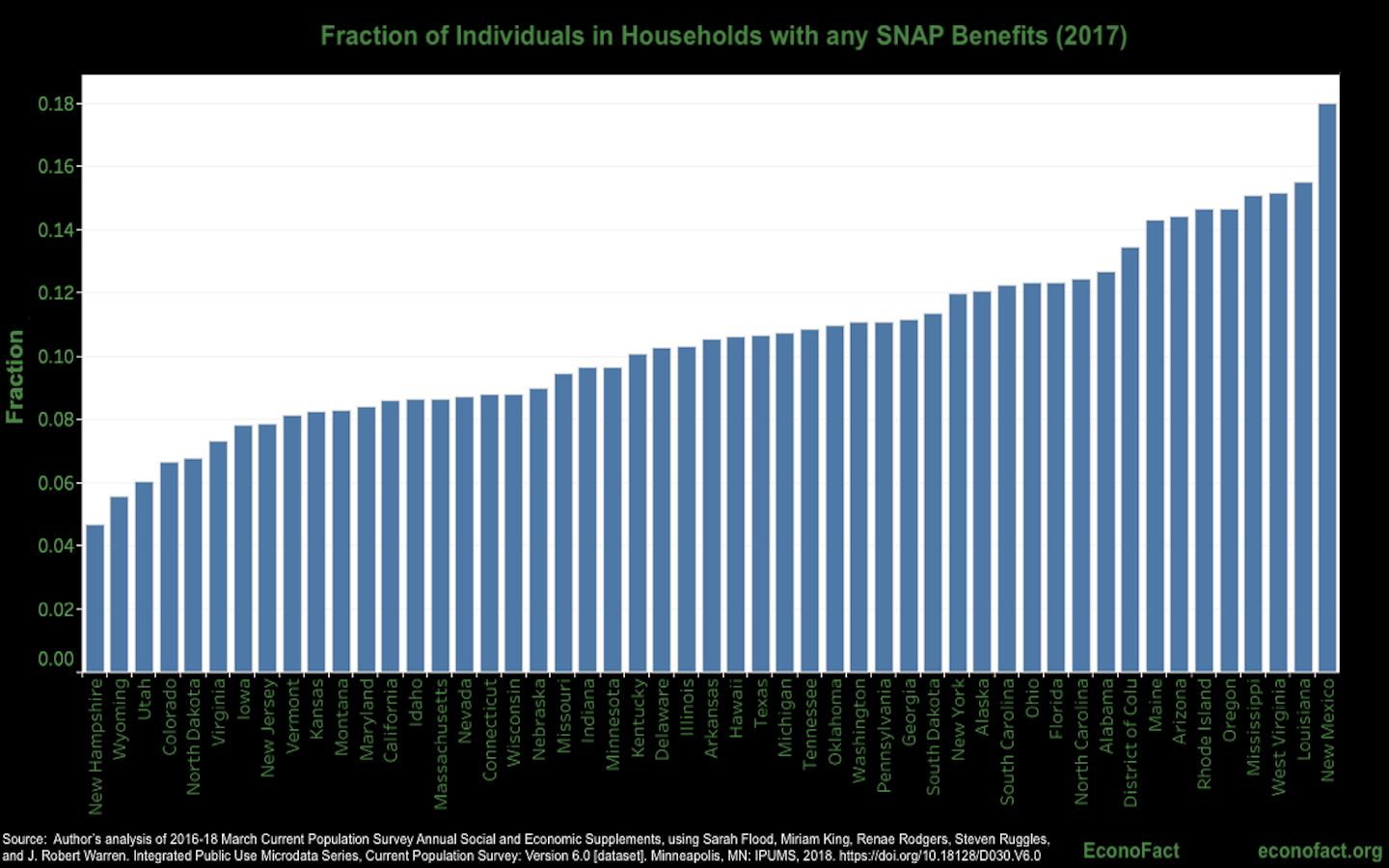SNAP Benefits and the Government Shutdown
·January 23, 2019
Williams College
Williams College
(Click here for a larger version.)
The Issue:
Millions of Americans rely on the Supplemental Nutrition Assistance Program (SNAP, formerly known as Food Stamps) to make ends meet. Though benefit payments have been made for February, the Federal appropriations lapse means that March payments may be in jeopardy.
About one sixth of all children in the U.S. lived in households with SNAP benefits in 2017
The Facts:
- Approximately 20 million households with 40 million individuals used the SNAP program in Fiscal Year 2018, according to data from the U.S. Department of Agriculture. The average monthly benefit is around $250 per participating household. Survey data suggest about 9.2 percent of all U.S. households reported receiving SNAP at some point during 2017, down from a peak of 11.8 percent in 2013, based on my analysis of the March 2018 Current Population Survey Annual Social and Economic Supplement. However, there is variation from state to state: while the fraction of individuals living in households that received benefits in 2017 was over 15 percent in New Mexico, Louisiana, West Virginia and Mississippi, it was below 6 percent in New Hampshire and Wyoming (see chart).
- Children are more likely than adults to live in households receiving SNAP. About 16.7 percent of children — one sixth of all children in the United States lived in households with SNAP benefits in 2017, based on my analysis of the March 2018 Current Population Survey Annual Social and Economic Supplement. Of all individuals who lived in households that received SNAP benefits in 2017: about half are below the poverty line and more than 70 percent lived with an adult who worked during the year. SNAP benefits reached an important share of children in poverty, providing support to over 55.5 percent of poor children in the United States in 2017, according to my estimates. Looking at children specifically is important because research is finding evidence that children who receive SNAP benefits, especially at younger ages, see improved health and economic outcomes that persist into adulthood (see this EconoFact).
- Most recipients received their February 2019 SNAP benefits early, around January 20th, in an effort by USDA to make sure the February funds would be dispersed. The funding bill expiring December 22nd allowed agencies to make certain obligated payments for 30 days. But if the shut-down continues, it is likely that March payments would be delayed.
- Even if the budget impasse is resolved soon enough for an on-time March disbursement, the early February benefit would imply a 40-day window between benefit payments — which represents potential hardship for some families. Prior research has shown that some SNAP households use up their benefits and run short on food before the end of the month, so there may be increased pressure on emergency food supports such as food pantries in late February. Such scarcity that occurs at the end of the benefit cycle has been associated with other problems. For instance, research has found that students with a longer time since their household’s last SNAP benefit payment have more disciplinary incidents in schools.
- Food insecure households see their access to food limited due to lack of money or other resources at certain times during the year. Food and nutrition support programs such as SNAP aim to reduce this food insecurity. Still, 11.8 percent (15.0 million households) were food insecure in 2017 and 4.5 percent of U.S. households (5.8 million households) had very low food security, meaning “the food intake of some household members was reduced and normal eating patterns were disrupted at times during the year due to limited resources,” according to the Economic Research Service of the USDA.
- Interruptions to SNAP have the potential to have an impact beyond the households who receive benefits. SNAP benefits are accepted at about 260,000 retailers and represent about 5 billion dollars a month in revenue to those firms. However, we should not expect to see a 5 billion dollar drop in food spending if March benefits are not issued. For most households, SNAP benefits are “infra-marginal,” meaning that the loss in SNAP benefits will be partially reflected in a drop in food consumption and partially reflected in reduced household spending on other budget items. (This is because research finds that SNAP benefits, for most families, are equivalent to receiving extra income — receiving benefits increases their purchase of food as well as of other non-food items.)
What this Means:
If the shutdown delays March SNAP benefits, millions of households would be directly impacted, including one-sixth of American children. There will also be indirect adverse impacts on emergency food supports and food retailers.
Written by The EconoFact Network. To contact with any questions or comments, please email [email protected].

